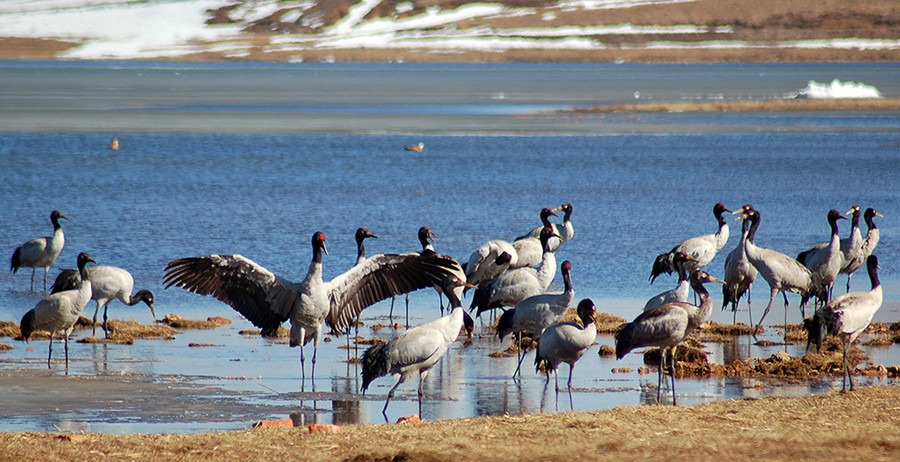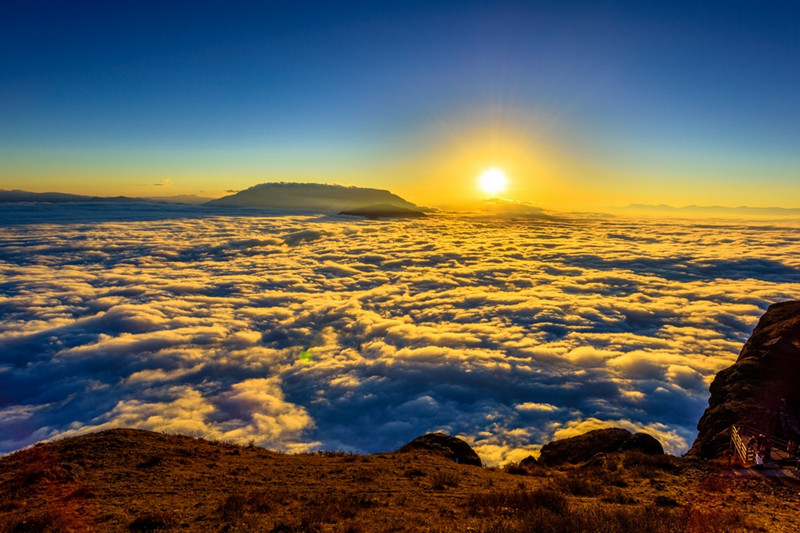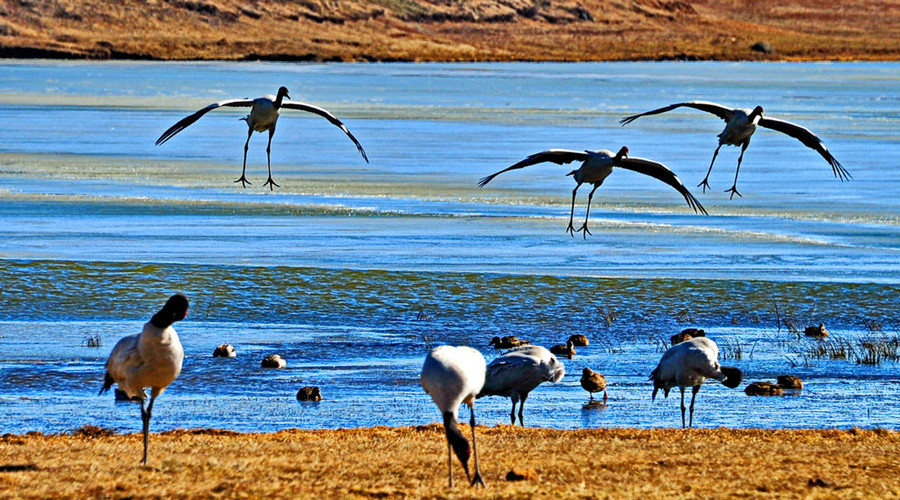
Birding Travel Tips for Dashanbao Nature Reserve in Zhaotong
大山包 (Dashanbao), located in the western part of Zhaotong City, is approximately 80 kilometers from the urban area, with an altitude ranging from 3100 to 3140 meters and an average annual temperature of 6.2°C. As a winter habitat for the nationally protected species, the Black-necked Crane, it has gained recognition among scientists and photographers both domestically and internationally.
Dashanbao Nature Reserve is situated in the Wulianfeng Mountain Range in northeastern Yunnan. Dashanbao itself is the main peak, characterized by its high mountain erosion structure, with altitudes mostly between 3000 to 3200 meters. The highest point is Kecheliangzi at 3364 meters, and the lowest point is at the junction of Banpo Village, Laolin Village Committee, and Ludian County’s Qinggou Cross, with an altitude of 2210 meters and a relative height difference of 1154 meters.
As winter approaches, flocks of Black-necked Cranes can be seen at the Tiaodun River Reservoir and Dahai Lake in Dashanbao, showcasing their graceful dance amidst the backdrop of a world covered in ice and snow, where the land, villages, and trees are draped in silver. The crystalline ice crystals cling to every corner of the mountains and fields, adding to the fascination brought by the arrival of the Black-necked Cranes from afar.
The Black-necked Crane is a first-class protected animal in China and one of the least known crane species in the world. In summer, they mainly nest in remote and high-altitude areas of the Qinghai-Tibet Plateau, with sparse human population, and migrate to lower altitudes for winter.
Currently, there are only about 8000 Black-necked Cranes worldwide, with over 4000 residing in China. By 2009, more than 1200 Black-necked Cranes were estimated to winter in Dashanbao.
Recommended Best Birdwatching Spots: Among the numerous wetlands in Dashanbao, the most concentrated area for Black-necked Cranes is the “Dahai Lake Wetland,” locally known as “Yange Lake.” A bird-watching platform is located about a hundred meters away from the lake, with many hides built in the bird activity areas for photographers. When visiting Dashanbao, you can enjoy birdwatching, observe sea of clouds, witness sunset, and also interact with local residents to learn about their customs, and taste local home-cooked specialties.
Travel Tips: From Kunming, you can choose to fly or take a bus to Zhaotong, then transfer to Dashanbao and further to the Black-necked Crane Nature Reserve. However, it is most convenient to rent a car upon arrival in Dashanbao for a reasonable travel arrangement. This destination is ideal for tourists interested in car rentals and self-driving tours.
During November and December each year, Black-necked Cranes migrate from the Qinghai-Tibet Plateau to Dashanbao, where “unmarried” cranes complete their courtship rituals. They stay here until March of the following year, returning to their breeding grounds on the Qinghai-Tibet Plateau. Therefore, the best time to observe Black-necked Cranes in Dashanbao is from December to March.
I visited Dashanbao in March 2010 while traveling from Yibin to Hongtudi and Yuanyang via Zhaotong. At that time, Dahai Lake and Jigong Mountain did not charge entrance fees, but they may have changed since then. Other conditions are likely similar, which I hope is helpful.
Travel Tips:
Getting There:
- It’s advisable to self-drive if possible, preferably in a rugged vehicle like an off-road or high-clearance SUV.
- Dashanbao Township is about 80 kilometers from Zhaotong City. The road to Dashanbao Township is newly paved, mostly asphalt with some sections of cement, providing good road conditions. However, there are many winding mountain roads, so drive safely, as it’s easy to get motion sickness.
- The scenic area has gravel roads that are rough and uneven. Drive cautiously to avoid damaging the chassis and tires on sharp rocks.
Birdwatching Tips:
- Choose the best viewing times, typically during the transitional seasons of spring/summer and autumn/winter.
- Maintain a sufficient distance from the birds, avoid entering water bodies, and refrain from touching bird excrement to ensure their safety.
- Avoid loud noises that could disturb the birds, as well as any actions that could scare them away.
- Essential birdwatching equipment includes binoculars to enhance your experience. For capturing moments with a camera, bring a telephoto lens of at least 200mm.
Additional Considerations:
- Dashanbao is at a high altitude, which may cause altitude sickness. Those with health issues should consider not traveling alone or perhaps not visiting directly.
- The area experiences significant temperature differences between day and night. Dress warmly to protect against cold weather.
- During the rainy season, seek shelter indoors if it rains to avoid lightning strikes. Never become too enamored with the scenery to overlook safety precautions.
Equipment:
- Da Shan Bao is at an altitude of over 3,100 meters, so beware of altitude sickness.
- Da Shan Bao’s average annual temperature is only 6 degrees Celsius. Despite how hot it may be in Zhaotong, mornings and evenings in Da Shan Bao are cold!
- Strong winds in the morning and evening are bone-chilling. A windbreaker or down jacket and a woolen hat that covers the ears are essential.
- Due to the rugged and uneven roads, hiking boots or military boots are recommended.
Photography:
- Before setting out to photograph black-necked cranes, it’s advisable to consult with the crane feeders at Da Hai Zi Wetland: Zhao Qiang at 13887121579 or Chen Guanghui at 15974861048.
- For clearer bird observation, a high-powered telescope is highly recommended. If planning to capture sunrise, remember to bring a flashlight.
- For bird photography, a lens with a focal length of at least 400mm, preferably 600mm, is recommended. Even with a 28-300mm lens plus a 2X extender, I found it somewhat inadequate.
Accommodation:
- Upon arrival in the town of Da Shan Bao, it’s recommended to secure accommodations before entering the scenic area. You can visit Ji Gong Shan to watch the sunset. The best option is “Highland Red Hotel” (0870-2865030), with standard rooms around 100 RMB, offering decent conditions. Hongyun Hostel is also reportedly good. Many local residents operate family inns, which are more basic but cheaper.
Activities:
- It’s emphasized not to disturb the shy and cautious black-necked cranes. Please strictly follow the scenic area regulations.
- The best time to visit Da Shan Bao is during autumn and winter: autumn for scenery and winter for observing cranes.
- From August to early October, the hills are covered with fields of buckwheat, oats, and colorful wildflowers. Additionally, during winter at Da Shan Bao’s Tiao Dun He Reservoir and Da Hai Zi Reservoir, you can see flocks of cranes dancing by the water’s edge, foraging and resting.
Sites to Visit:
- Da Hai Zi Wetland: Da Hai Zi Wetland is where the black-necked cranes spend the night and is an excellent spot for photography enthusiasts to capture sunrise. Along the right side of the street in Da Shan Bao town, a small path leads to the Da Hai Zi Wetland Protection Area, about 5 kilometers away. Every morning, as the sun rises, you can witness thousands of black-necked cranes dancing by the water. As the sun ascends, they take flight to nearby areas foraging. At noon, the protection area provides food on the grass in front of the bird-watching room, where the cranes gather for a “feast.”
- Tiao Dun He and Ji Gong Shan: Ji Gong Shan scenic area is ideal for viewing sea of clouds and sunsets, especially suitable for sunset photography. Located 7 kilometers from Da Shan Bao town, you can reach Tiao Dun He Wetland and Ji Gong Shan scenic area by walking or riding along a bumpy mountainous dirt road directly from the street. After passing through the grassland, where during the day black-necked cranes gather to forage at the foot of the mountain away from the road, you will quickly reach the Tiao Dun He Dam. Next to it is a parking lot where you can park your car and walk or ride a horse to Ji Gong Shan.
Here are the photos I took at Da Shan Bao. Arriving at Da Hai Zi Reservoir was exactly at noon, with strong sunlight, resulting in less than ideal conditions. The following two days were filled with heavy fog, with no visibility all day, shattering my dream of photographing cranes at sunrise, leaving me disappointed.

 7 Days GolfingTour
7 Days GolfingTour
 8 Days Group Tour
8 Days Group Tour
 8 Days Yunnan Tour
8 Days Yunnan Tour
 7 Days Shangri La Hiking
7 Days Shangri La Hiking
 11 Days Yunnan Tour
11 Days Yunnan Tour
 6 Days Yuanyang Terraces
6 Days Yuanyang Terraces
 11 Days Yunnan Tour
11 Days Yunnan Tour
 8 Days South Yunnan
8 Days South Yunnan
 7 Days Tea Tour
7 Days Tea Tour
 8 Days Muslim Tour
8 Days Muslim Tour
 12 Days Self-Driving
12 Days Self-Driving
 4 Days Haba Climbing
4 Days Haba Climbing
 Tiger Leaping Gorge
Tiger Leaping Gorge
 Stone Forest
Stone Forest
 Yunnan-Tibet
Yunnan-Tibet
 Hani Rice Terraces
Hani Rice Terraces
 Kunming
Kunming
 Lijiang
Lijiang
 Shangri-la
Shangri-la
 Dali
Dali
 XishuangBanna
XishuangBanna
 Honghe
Honghe
 Kunming
Kunming
 Lijiang
Lijiang
 Shangri-la
Shangri-la
 Yuanyang Rice Terraces
Yuanyang Rice Terraces
 Nujiang
Nujiang
 XishuangBanna
XishuangBanna
 Spring City Golf
Spring City Golf
 Snow Mountain Golf
Snow Mountain Golf
 Stone Mountain Golf
Stone Mountain Golf


















